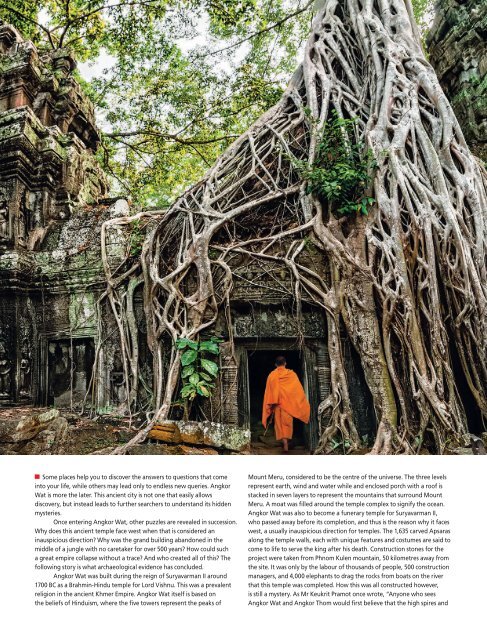WE Smile Magazine February 2016
The In-Flight Magazine of Thai Smile Airways
The In-Flight Magazine of Thai Smile Airways
You also want an ePaper? Increase the reach of your titles
YUMPU automatically turns print PDFs into web optimized ePapers that Google loves.
Some places help you to discover the answers to questions that come<br />
into your life, while others may lead only to endless new queries. Angkor<br />
Wat is more the later. This ancient city is not one that easily allows<br />
discovery, but instead leads to further searchers to understand its hidden<br />
mysteries.<br />
Once entering Angkor Wat, other puzzles are revealed in succession.<br />
Why does this ancient temple face west when that is considered an<br />
inauspicious direction? Why was the grand building abandoned in the<br />
middle of a jungle with no caretaker for over 500 years? How could such<br />
a great empire collapse without a trace? And who created all of this? The<br />
following story is what archaeological evidence has concluded.<br />
Angkor Wat was built during the reign of Suryavarman II around<br />
1700 BC as a Brahmin-Hindu temple for Lord Vishnu. This was a prevalent<br />
religion in the ancient Khmer Empire. Angkor Wat itself is based on<br />
the beliefs of Hinduism, where the five towers represent the peaks of<br />
Mount Meru, considered to be the centre of the universe. The three levels<br />
represent earth, wind and water while and enclosed porch with a roof is<br />
stacked in seven layers to represent the mountains that surround Mount<br />
Meru. A moat was filled around the temple complex to signify the ocean.<br />
Angkor Wat was also to become a funerary temple for Suryavarman II,<br />
who passed away before its completion, and thus is the reason why it faces<br />
west, a usually inauspicious direction for temples. The 1,635 carved Apsaras<br />
along the temple walls, each with unique features and costumes are said to<br />
come to life to serve the king after his death. Construction stones for the<br />
project were taken from Phnom Kulen mountain, 50 kilometres away from<br />
the site. It was only by the labour of thousands of people, 500 construction<br />
managers, and 4,000 elephants to drag the rocks from boats on the river<br />
that this temple was completed. How this was all constructed however,<br />
is still a mystery. As Mr Keukrit Pramot once wrote, “Anyone who sees<br />
Angkor Wat and Angkor Thom would first believe that the high spires and

















